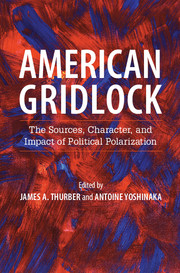Book contents
- Frontmatter
- Dedication
- Contents
- List of contributors
- Foreword
- Acknowledgments
- Introduction
- PART I POLARIZATION AMONG VOTERS AND ACTIVISTS
- PART II POLARIZATION IN NATIONAL INSTITUTIONS
- PART III POLARIZATION IN THE STATES
- PART IV POLARIZATION IN THE MEDIA
- 12 Partisan Media and Electoral Polarization in 2012: Evidence from the American National Election Study
- 13 News as a Casualty: District Polarization and Media Coverage of U.S. House Campaigns
- 14 More a Symptom Than a Cause: Polarization and Partisan News Media in America
- 15 The Polarizing Effects of Partisan and Mainstream News
- PART V IMPLICATIONS AND CONCLUSIONS
- Index
- References
15 - The Polarizing Effects of Partisan and Mainstream News
from PART IV - POLARIZATION IN THE MEDIA
Published online by Cambridge University Press: 05 November 2015
- Frontmatter
- Dedication
- Contents
- List of contributors
- Foreword
- Acknowledgments
- Introduction
- PART I POLARIZATION AMONG VOTERS AND ACTIVISTS
- PART II POLARIZATION IN NATIONAL INSTITUTIONS
- PART III POLARIZATION IN THE STATES
- PART IV POLARIZATION IN THE MEDIA
- 12 Partisan Media and Electoral Polarization in 2012: Evidence from the American National Election Study
- 13 News as a Casualty: District Polarization and Media Coverage of U.S. House Campaigns
- 14 More a Symptom Than a Cause: Polarization and Partisan News Media in America
- 15 The Polarizing Effects of Partisan and Mainstream News
- PART V IMPLICATIONS AND CONCLUSIONS
- Index
- References
Summary
• Strong partisans gravitate toward like-minded partisan media.
• Like-minded media use can polarize attitudes and, in some instances, so can the use of counter-attitudinal media.
• An experiment using NBC, MSNBC, and Fox News coverage of the Keystone XL Pipelinee's environmental impact shows that media coverage affects attitudes and beliefs.
• Drawing from inoculation theory, like-minded news polarized attitudes, and watching a combination of like-minded and mainstream news coverage did little to reduce polarization.
On January 31, 2014, the U.S. Department of State released its “Final Supplemental Environmental Impact Statement for the Keystone XL Project.” The report garnered substantial attention. Would the pipeline have a devastating environmental impact as some groups had alleged? Or was the effect minimal and offset by the prospect of a reliable source of oil and an influx of new jobs? If you learned about this report from television, your answer to these questions would depend on which outlet you watched. According to Fox News, the report concluded that the environmental impact would be minimal. MSNBC, however, highlighted the environmentally damaging effects of not only the tar sands that would travel through the pipeline, but also the natione's continuing dependence on oil. NBC News noted that there would be some environmental impact, but it would be minimal and that although jobs would be created, there wouldne't be many and they would be short term. All three outlets covered exactly the same report, but each was unique in its coverage.
The Keystone Pipeline report is an illuminating case study of how information is presented in todaye's fragmented media environment. Partisan outlets have decidedly different takes on the daye's news and events. Based on these divergent portrayals, audiences may rely on unique sets of facts to support polarized attitudes and opinions about important political matters. It is precisely this topic that we tackle in this chapter. To begin, we briefly describe evidence regarding partisan selective exposure, the selection of politically like-minded media. Our review lays the groundwork for why partisan media are relevant for understanding polarization. Next, we present an overview of research on how the media affect partisans’ political beliefs, opinions, and attitudes. Equipped with this background, we turn to the Keystone Pipeline report and present original data on how people react to the coverage. Our case study illustrates the mediae's ability to polarize beliefs and attitudes.
- Type
- Chapter
- Information
- American GridlockThe Sources, Character, and Impact of Political Polarization, pp. 337 - 354Publisher: Cambridge University PressPrint publication year: 2015
References
- 4
- Cited by



